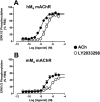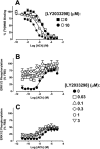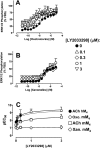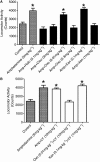Impact of species variability and 'probe-dependence' on the detection and in vivo validation of allosteric modulation at the M4 muscarinic acetylcholine receptor
- PMID: 21198541
- PMCID: PMC3057301
- DOI: 10.1111/j.1476-5381.2010.01184.x
Impact of species variability and 'probe-dependence' on the detection and in vivo validation of allosteric modulation at the M4 muscarinic acetylcholine receptor
Abstract
Background and purpose: We recently characterized LY2033298 as a novel allosteric modulator and agonist at M(4) muscarinic acetylcholine receptors (mAChRs). Evidence also suggested a difference in the potency of LY2033298 at rodent relative to human M(4) mAChRs. The current study investigated the basis for the species difference of this modulator and used this knowledge to rationalize its in vivo actions.
Experimental approach: LY2033298 was investigated in vitro in CHO cells stably expressing human or mouse M(4) mAChRs, using assays of agonist-induced ERK1/2 or GSK-3α phosphorylation, [(35) S]-GTPγS binding, or effects on equilibrium binding of [(3) H]-NMS and ACh. The in vivo actions of LY2033298 were investigated in a mouse model of amphetamine-induced locomotor activity. The function of LY2033298 was examined in combination with ACh, oxotremorine or xanomeline.
Key results: LY2033298 had similar affinities for the human and mouse M(4) mAChRs. However, LY2033298 had a lower positive co-operativity with ACh at the mouse relative to the human M(4) mAChR. At the mouse M(4) mAChR, LY2033298 showed higher co-operativity with oxotremorine than with ACh or xanomeline. The different degrees of co-operativity between LY2033298 and each agonist at the mouse relative to the human M(4) mAChR necessitated the co-administration of LY2033298 with oxotremorine in order to show in vivo efficacy of LY2033298.
Conclusions and implications: These results provide evidence for species variability when comparing the allosteric interaction between LY2033298 and ACh at the M(4) mAChR, and also highlight how the interaction between LY2033298 and different orthosteric ligands is subject to 'probe dependence'. This has implications for the validation of allosteric modulator actions in vivo.
© 2011 The Authors. British Journal of Pharmacology © 2011 The British Pharmacological Society.
Figures






Similar articles
-
Molecular mechanisms of action and in vivo validation of an M4 muscarinic acetylcholine receptor allosteric modulator with potential antipsychotic properties.Neuropsychopharmacology. 2010 Mar;35(4):855-69. doi: 10.1038/npp.2009.194. Epub 2009 Nov 25. Neuropsychopharmacology. 2010. PMID: 19940843 Free PMC article.
-
New insights into the function of M4 muscarinic acetylcholine receptors gained using a novel allosteric modulator and a DREADD (designer receptor exclusively activated by a designer drug).Mol Pharmacol. 2008 Oct;74(4):1119-31. doi: 10.1124/mol.108.049353. Epub 2008 Jul 15. Mol Pharmacol. 2008. PMID: 18628403
-
Probe dependence in the allosteric modulation of a G protein-coupled receptor: implications for detection and validation of allosteric ligand effects.Mol Pharmacol. 2012 Jan;81(1):41-52. doi: 10.1124/mol.111.074872. Epub 2011 Oct 11. Mol Pharmacol. 2012. PMID: 21989256
-
Discovery and Development of Muscarinic Acetylcholine M4 Activators as Promising Therapeutic Agents for CNS Diseases.Chem Pharm Bull (Tokyo). 2018;66(1):37-44. doi: 10.1248/cpb.c17-00413. Chem Pharm Bull (Tokyo). 2018. PMID: 29311510 Review.
-
The Prosperity and Adversity of M4 Muscarinic Acetylcholine Receptor Activators in the Treatment of Neuropsychiatric Disorders.J Med Chem. 2025 Apr 24;68(8):7932-7954. doi: 10.1021/acs.jmedchem.5c00678. Epub 2025 Apr 16. J Med Chem. 2025. PMID: 40237346 Review.
Cited by
-
The unconventional activation of the muscarinic acetylcholine receptor M4R by diverse ligands.Nat Commun. 2022 May 23;13(1):2855. doi: 10.1038/s41467-022-30595-y. Nat Commun. 2022. PMID: 35606397 Free PMC article.
-
Xanomeline displays concomitant orthosteric and allosteric binding modes at the M4 mAChR.Nat Commun. 2023 Sep 6;14(1):5440. doi: 10.1038/s41467-023-41199-5. Nat Commun. 2023. PMID: 37673901 Free PMC article.
-
Structure-Activity Relationships of Pan-Gαq/11 Coupled Muscarinic Acetylcholine Receptor Positive Allosteric Modulators.ACS Chem Neurosci. 2018 Jul 18;9(7):1818-1828. doi: 10.1021/acschemneuro.8b00136. Epub 2018 Apr 30. ACS Chem Neurosci. 2018. PMID: 29683647 Free PMC article.
-
Pharmacological hallmarks of allostery at the M4 muscarinic receptor elucidated through structure and dynamics.Elife. 2023 May 30;12:e83477. doi: 10.7554/eLife.83477. Elife. 2023. PMID: 37248726 Free PMC article.
-
Positive allosteric modulation of M1 and M4 muscarinic receptors as potential therapeutic treatments for schizophrenia.Neuropharmacology. 2018 Jul 1;136(Pt C):438-448. doi: 10.1016/j.neuropharm.2017.09.012. Epub 2017 Sep 9. Neuropharmacology. 2018. PMID: 28893562 Free PMC article. Review.
References
-
- Aurelio L, Valant C, Flynn BL, Sexton PM, Christopoulos A, Scammels PJ. Allosteric modulators of the adenosine A1 receptor: synthesis and pharmacological evaluation of 4-Substituted 2-Amino-3-benzoylthiophenes. J Med Chem. 2009;52:4543–4547. - PubMed
-
- Black JW, Leff P. Operational Models of Pharmacological Agonism. Proc R Soc Lond B Biol Sci. 1983;220:141–162. - PubMed
-
- Buckley P, Stahl SM. Pharmacological treatment of negative symptoms of schizophrenia: therapeutic opportunity or Cul-de-sac? Acta Psychiatr Scand. 2007;115:93–100. - PubMed
Publication types
MeSH terms
Substances
LinkOut - more resources
Full Text Sources
Miscellaneous

